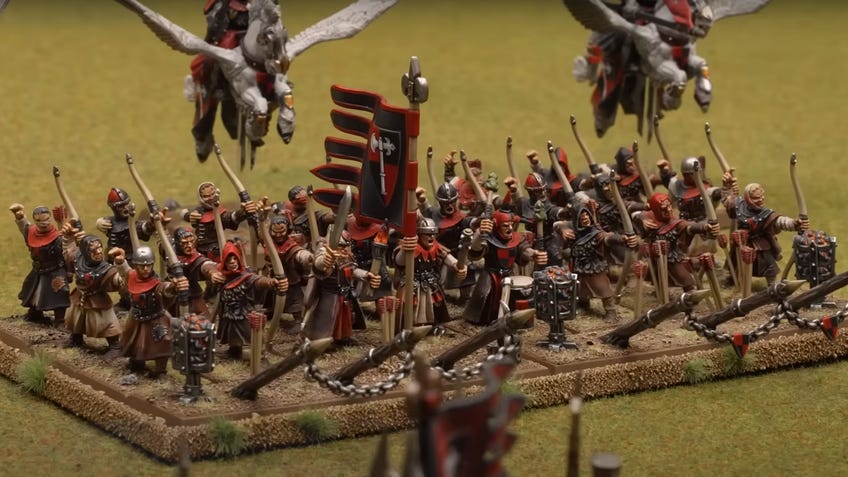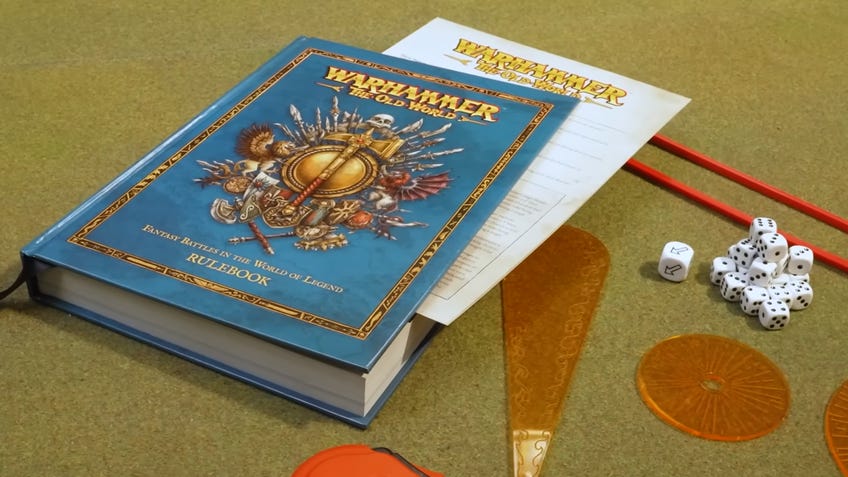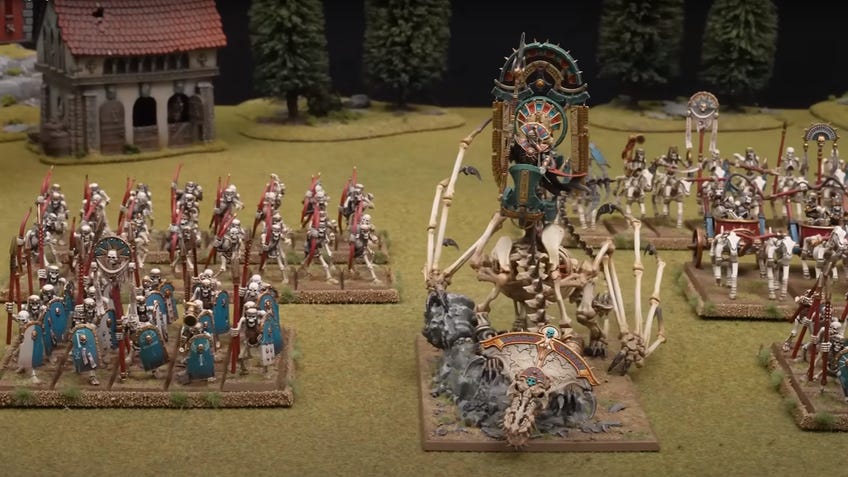Warhammer: The Old World is a cynical exercise in mining nostalgia - and cash - from Fantasy Battle fans
The reboot of the pre-Age of Sigmar wargame brings back old models and a few new ideas for an inflated price.
Nostalgia is big business these days. The combination of risk-averse corporations and millennials hitting their thirties and forties means that sticking old stuff on a T-shirt or a Funko Pop is a great way to make a lot of money with very little effort. Games Workshop’s Warhammer: The Old World isn’t quite that lazy, instead being a curious mix of old and new that is trying to grab the attention, and wallets, of both tabletop gamers wanting to relive their youth and folks still not over the destruction of the Old World almost a decade ago.
Warhammer: The Old World is a new edition of Warhammer Fantasy Battle in all but name. This was the original flavour of Warhammer, before declining sales saw Games Workshop literally blow up the world and replace it with Age of Sigmar in 2015.
While many of the rules and concepts of both Fantasy Battle and The Old World will be familiar to anyone who has played a GW game, their main point of difference is that they are rank-and-flank games, with models on square and rectangular bases neatly lined up in formation. These rigid units, as opposed to the looser unit coherency seen in Warhammer 40,000 and Age of Sigmar, make movement and positioning even more important; a charge into the flank or rear of a unit can be devastating.
What makes the launch of The Old World so unusual is the eclectic mix of products involved. While GW is producing new miniatures for the game, the majority of the models are re-releases of old (in some cases really old) figures. As a result, the launch range includes new plastic miniatures, new Forge World resin miniatures, old plastic miniatures and old metal miniatures, while other old metal or Finecast miniatures have been retooled as Forge World resin. Phew!
As you can imagine, relaunching such a massive range is a huge logistical trial, so Games Workshop has decided to focus on nine of the classic Warhammer Fantasy Battle factions for The Old World, with the rest being supported in free PDF army list form.
Of those nine, the initial release consists of the Bretonnians, a land of knights and chivalry inspired by Arthurian legend and mediaeval France; and the Tomb Kings, skeletal undead with a distinctly Ancient Egyptian flavour. While a lot of Warhammer Fantasy factions and their accompanying miniature ranges made the jump to Age of Sigmar and still have Fantasy Battle models available today, both the Bretonnians and Tomb Kings disappeared entirely, so it makes sense why GW would choose these armies in particular.

Perhaps the most interesting aspect of The Old World’s launch line-up is that there are actually two starter sets to choose from. Rather than a single box featuring two opposing forces, you can grab a core box for either the Bretonnians or Tomb Kings which includes the core rulebook and an entire starter army, along with a booklet that allows you to play the army straight out of the box. I was sent the Bretonnian set to take a look at, so that’s what I’ll be talking about here, although I have no reason to believe the same things don’t apply to the Tomb Kings box.
While I am a huge fan of a “game in a box” starter, which allows two people to play a representative and entertaining game with the core set and nothing else, the nature of The Old World makes that quite tricky. Warhammer Fantasy has never scaled particularly well and trying to play a small game without a variety of units on each side just isn’t much fun. GW’s last Specialist Games release, Warhammer 40,000 spin-off Legions Imperialis, had an absolute disaster of a starter set, which didn’t work as either a two-player set or the core of a larger army. This approach is a much better one and I’d like to see it again in the future. Of course, if you’re not interested in either of those factions, the core rulebook is available on its own.
The Old World's two separate core boxes is a much better approach to a starter set than Legions Imperialis and one I'd like to see again in the future.
The core rulebook is absolutely massive, clocking in at just over 350 pages, and is exactly what you’d expect from Games Workshop. It’s well-made, stuffed full of gorgeous art and miniatures photography, looks great on a shelf and is completely impractical for use during a game. Yes, I know, I’ve been banging this drum for a while, but it’s a real problem. The book is a lovely object, but a terrible format for a rulebook, especially when you may need two other books to play the game (more on that in a bit).
One interesting thing to note is that the background section does include a couple of pages on Grand Cathay. This China-inspired land has been part of the setting for many years, but was only fleshed out in the video game Total Warhammer 3 by developer Creative Assembly, who are credited in the book, unlike any of the individual Games Workshop staff who worked on The Old World. Early teases suggested Grand Cathay might appear in The Old World, but it’s clear the game that has arrived is much different from those early glimpses.

In terms of miniatures, the Bretonnian box contains 76 plastic models, of which one is new. The Bretonnian Lord on Pegasus is of the typically high standard of modern Warhammer and will make for an excellent painting project or army centrepiece. The others, a mixture of mounted knights and footslogging peasants, date back to 2003 and have held up surprisingly well. Just glancing at the sprues is enough to make you realise they’re of a certain vintage; instead of being tightly packed in, there’s a lot of empty space between bits, the details aren’t as crisp and mould lines are more noticeable.
Having recently built and painted plastic Middle-earth minis of a similar age, I was expecting these to be much worse, but they look good and only need a little more cleanup than current releases. I don’t think this re-use of old minis is necessarily a bad thing. The Old World is a game designed to have a lot of minis on the table and the packed ranks of units means that there’s not a lot of room for fancy poses. When you’re painting blocks of 24 bowmen, you don’t want a lot of fiddly details and the old and new minis blend together just fine.
The issue is that these 20-year-old minis are being sold for the same price as brand new ones. The contents and price point of this box are comparable to last year’s Leviathan launch set for tenth-edition Warhammer 40k, but those were all brand new sculpts. The pricing of miniatures is a complex mix of factors, but all the upfront costs, the design stages, the tooling and whatnot, were presumably accounted for decades ago. I’m not saying they should cost the same as they did when they were released - material and logistics costs go up, not to mention inflation - but charging the same for these as for new miniatures is insulting.

As I mentioned earlier, there is a pre-written army list and special rules included which allows you to field a 1,250-point force. (Standard games are 2,000 points.) If you want to expand your army or play any of the others, you’ll need to buy more books. Rather than going with the separate Battletome/Codex approach, GW has produced two indexes, Forces of Fantasy and Ravening Hordes, which each contain the army lists for several different factions. High Elves, Wood Elves, Bretonnians, Dwarves and the Empire in the former; Orcs and Goblins, Warriors of Chaos, Beastmen and Tomb Kings in the latter.
Nostalgia is the only thing The Old World has going for it.
The indexes are pretty barebones, containing a couple of pages of lore, unit profiles, magic items and any army special rules. If you want any special characters, more detailed background information or any other options beyond the basics, you’ll need yet another book, called an Arcane Journal. At launch these will only be available for Bretonnians and Tomb Kings and flesh out the contents of the army list books. From a player perspective, this format is utterly nonsensical. Not only do you have to pony up for the lists for three or four armies that aren’t the ones you’re playing, but you have to buy a third book to get the complete rules for your army.
These extra books are just the tip of the iceberg. Reference cards are available for common magic items and spells, with each of the two decks costing £24. Army-specific reference card decks are available for £16, but they don’t include unit profiles like the equivalent products for Age of Sigmar and 40k do. To protect these cards, you can pick up some The Old World card sleeves (a first for GW, I believe, outside of the card/minis hybrid game Warhammer Underworlds) for an additional £12. GW has also brought back modular movement trays, which are now £25 a box for something you could easily replicate with a few quid’s worth of plasticard and only a little more effort.

As for the game itself, a thorough read of the rules reveals a game that is, well, fine, I guess. It’s a hodgepodge of newer ideas, such as streamlined magic rules without a distinct magic phase, and clunky throwbacks like To-Hit and To-Wound charts. Nothing sticks out as being particularly bad, but compared to exciting, innovative rank-and-flank games like the superb Conquest, there’s nothing to recommend either.
It’s a good thing, at least from Games Workshop’s perspective, that nostalgia is such big business, as it’s the only thing The Old World has going for it. It’s clearly been designed to draw in players with promises of being like the good old days and squeezing them for everything it can. I don’t like being unnecessarily critical of GW - it’s no better or worse than any other large company in the industry - but this launch is as predatory and cynical as it gets.
A review copy of Warhammer: The Old World was provided by Games Workshop.

